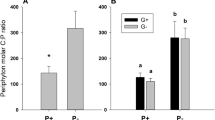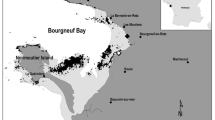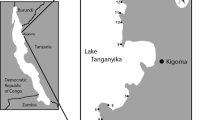Abstract
Aggregations of Melarhaphe neritoides and Littorina saxatilis are common on the high shore in north-east England. These aggregations are frequently found in crevices which act as a refuge from desiccation. The aggregations are surrounded by patches of epilithic biofilm which are visibly lighter in colour than the biofilm present on the remainder of the high shore. Chlorophyll a levels were lower in regions of close proximity to aggregated littorinids (mean = 4.9 μg cm−2) as compared to areas >‰5 cm away from the edge of the visible colour change (mean = 15.9 μg cm−2). Manipulations of littorinid density showed that areas of high density had significantly lower levels of chlorophyll a than those where littorinids were excluded. This difference was mainly due to the presence of higher numbers of small grazed areas or an increase in size of grazed areas rather than a homogenous change in chlorophyll a levels across the entire manipulated area. These results are supported by observations showing that only 7% of the total foraging time of littorinids was spent outside visibly lighter patches of biofilm suggesting littorinids only control local biofilm levels through grazing.
Similar content being viewed by others
References
L. Benedetticecchi F. Cinelli (1995) ArticleTitleHabitat heterogeneity, sea-urchin grazing and the distribution of algae in littoral rock pools on the west-coast of Italy (Western Mediterranean) Marine Ecology Progress Series 126 203–212
G. M. Branch M. L. Branch (1981) ArticleTitleExperimental analysis of intraspecific competition in an intertidal gastropod, Littorina unifasciata Australian Journal Marine and Freshwater Research 32 573–589
G. Chelazzi D. Parpagnoli G. Santini (1998) ArticleTitleA satiation model for the temporal organisation of grazing in limpets Functional Ecolology 12 203–210
J. H. Connell (1972) ArticleTitleCommunity interactions on marine rocky intertidal shores Annual Review of Ecological Systems 3 169–192
R. H. Emson R. J. Faller-Fritsch (1976) ArticleTitleAn experimental investigation into the effect of crevice availability on abundance and size structure in a population of Littorina rudis: Gastropoda; Prosobranchia Journal of Experimental Marine Biology and Ecology 23 285–297
P. G. Fairweather (1988) ArticleTitleExperiments on the interaction between predation and the availability of different prey on rocky seashores Journal of Experimental Marine Biology and Ecology 114 261–273
Fletcher A., 1980. Marine and maritime lichens of rocky shores: their ecology, physiology and biological interactions. In Price J. H., D. E. G. Irvine & W. F. Farnham (eds), The Shore Environment Vol. 2: Ecosystems. Academic Press: 789–842
B. Fretter A. Graham (1994) The British Prosobranch Molluscs Ray Society London
S. D. Garrity S. C. Levings (1983) ArticleTitleHoming to scars as a defence against predators in the pulmonate limpet Siphonaria gigas (Gastropoda) Marine Biology 72 319–324
S. J. Hawkins R. G. Hartnoll (1983) ArticleTitleGrazing of intertidal algae by marine invertebrates Oceanography and Marine Biology 21 195–282
M. P. Johnson R. N. Hughes M. T. Burrows S. J. Hawkins (1998) ArticleTitleBeyond the predation halo: small scale gradients in barnacle populations affected by the relative refuge value of crevices Journal of Experimental Marine Biology and Ecology 231 163–170
K. M. M. Jones E. G. Boulding (1999) ArticleTitleState dependent habitat selection by an intertidal snail: the cost of selecting a physically stressful microhabitat Journal of Experimental Marine Biology and Ecology 242 149–177
S. Kaehler P. W. Froneman (2002) ArticleTitleHerbivore-mediated increase in the photosynthetic capacity of marine biofilms: indirect effects of changing microalgal assemblage composition Marine Ecology Progress Series 234 15–22
C. J. Krebs (1989) Ecological Methodology Addison-Welsey Boston
C. Little (1989) ArticleTitleFactors governing patterns of foraging activity in littoral marine herbivorous molluscs Journal of Molluscan Studies 55 273–284
Mak, Y. M., 1996 The Ecology of the High-Zoned Littorinids Nodilittorina trochoides, N. radiata and N. vidua on Rocky Shores in Hong Kong. Ph.D. Thesis, University of Hong Kong
Y. M. Mak G. A. Williams (1999) ArticleTitleLittorinids control high intertidal biofilm abundance on tropical Hong Kong rocky shores Journal of Experimental Marine Biology and Ecology 223 81–94
R. F. McMahon (1990) ArticleTitleThermal tolerance, evaporative water loss, air water oxygen consumption and zonation of intertidal prosobranchs: a new synthesis Hydrobiologia 193 241–260
B. A. Menge (1978) ArticleTitlePredation intensity in a rocky intertidal community. Relation between predator foraging activity and environmental harshness Oecologia 34 1–16
B. A. Menge J. P. Sutherland (1987) ArticleTitleCommunity regulation: variation in disturbance, competition and predation in relation to environmental stress and recruitment American Naturalist 130 730–757
S. Nagarkar G. A. Williams (1997) ArticleTitleComparative techniques to quantify cyanobacteria dominated epilithic biofilms on tropical rocky shores Marine Ecology Progress Series 154 281–291
M. E. Nicotri (1977) ArticleTitleGrazing effects of four marine intertidal herbivores on the microflora Ecology 58 1020–1032
T. A. Norton S. J. Hawkins N. L. Manley G. A. Williams D. C. Watson (1990) ArticleTitleScraping a living-a review of littorinid grazing Hydrobiologia 193 117–138
C. M. Potter M. H. Schleyer (1991) ArticleTitleAspects of the biology of Natal Littorinidae: II. Feeding and food availability Investigations of the Republic Oceanographic Research Institute 66 1–15
D. G. Raffaelli R. N. Hughes (1978) ArticleTitleThe effects of crevice size and availability on populations of Littorina rudis and Littorina neritoides Journal of Animal Ecology 47 71–83
D. G. Reid (1996) Systematics and Evolution of Littorina The Ray Society London
Stafford, R., 2002. The role of environmental stress and physical and biological interactions on the ecology of high shore littorinids in a temperate and a tropical region. Ph.D. Thesis, University of Sunderland, UK
T. A. Stephenson A. Stephenson (1972) Life between Tidemarks on Rocky Shores W.H. Freeman and Co. New York
R. C. Thompson T. A. Norton S. J. Hawkins (2004) ArticleTitlePhysical stress and biological control regulate the producer-consumer balance in intertidal biofilm Ecology 85 1372–1382
A. J. Underwood (1979) ArticleTitleThe ecology of intertidal gastropods Oceanography and Marine Biology Annual Review 16 111–210
A. J. Underwood (1997) Experiments in Ecology Cambridge University Press Cambridge
A. J. Underwood E. J. Denley (1984) Paradigms, explanations and generalisations in models for the structure of intertidal communities on rocky shores D. R., Strong D. Simberloff L. G. Abele A. B. Thistle (Eds) Ecological Communities, Conceptual Issues and the Evidence Princeton University Press New Jersey 151–180
A. J. Underwood P. Jernakoff (1984) ArticleTitleThe effects of tidal height, wave-exposure, seasonality and rock-pools on grazing and the distribution of intertidal macroalgae in New South Wales Journal of Experimental Marine Biology and Ecology 75 71–96
Author information
Authors and Affiliations
Corresponding author
Additional information
This paper has not been submitted elsewhere in identical or similar form, nor will it be during the first three months after its submission to Hydrobiologia
Rights and permissions
About this article
Cite this article
Stafford, R., Davies, M.S. Spatial patchiness of epilithic biofilm caused by refuge-inhabiting high shore gastropods. Hydrobiologia 545, 279–287 (2005). https://doi.org/10.1007/s10750-005-3320-5
Received:
Revised:
Accepted:
Issue Date:
DOI: https://doi.org/10.1007/s10750-005-3320-5




